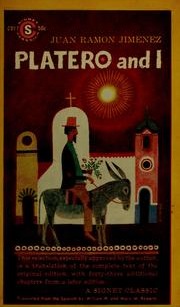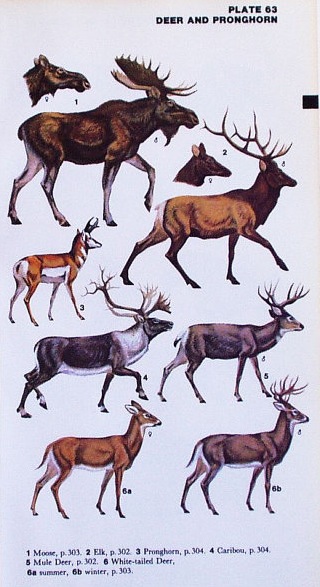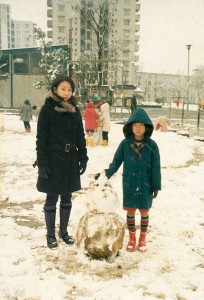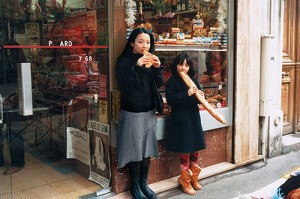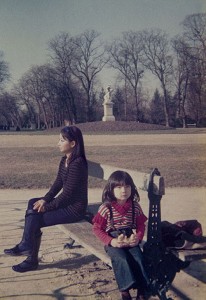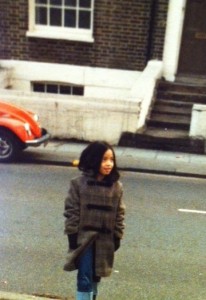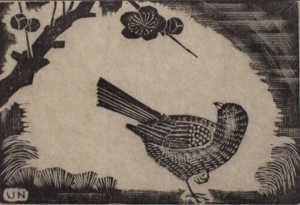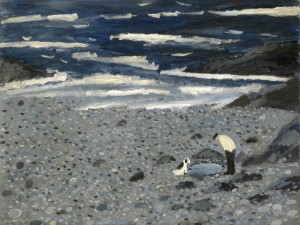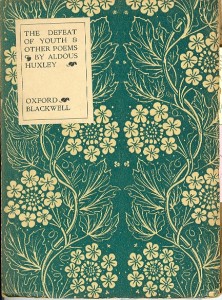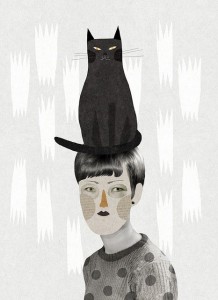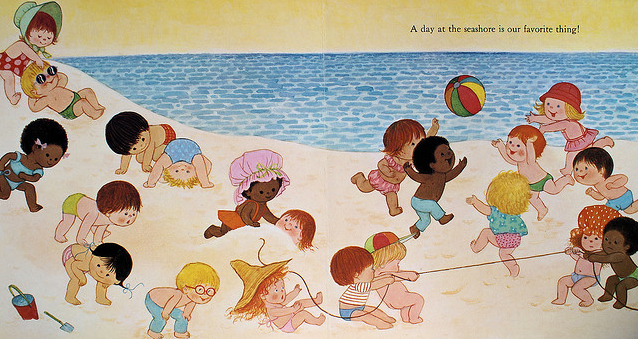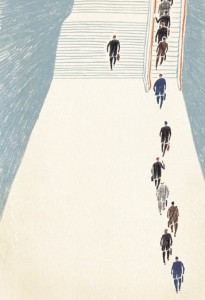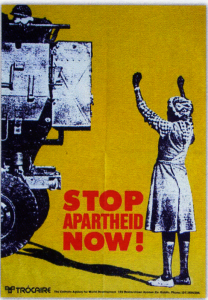When I was 17 years-old, I happened upon this eccentric book by Juan Ramón Jiménez in a small second-hand bookshop in Toronto, which led me to become interested in Andalusia, which led me to the music of Paco de Lucia (RIP, 1947-2014), which (in a way) led me to study Spanish in university, which (definitely) led me to travel to Spain with my best friend when I was 19, which (later) led me to return (three times), which (coincidentally) led me to be there when I realized that I was in love with my (now) husband, which led us to make some dramatic decisions that would put us in the same city at the same time, which (eventually) led us to travel back to Spain for our honeymoon…which (finally) makes me wonder about Actual Book Chains and whether they can (as often or as easily) trigger these kind of accidental life-changing reactions.
“My friend Malcolm told me a story about pronghorns recently, the North American creatures sometimes confused with antelopes. They can run at speeds of nearly sixty miles an hour, much, much faster than any of their existing predators. Some biologists think they’re still outrunning the dangerous species that went extinct at the end of the Pleistocene, specifically the cheetahs that existed on this continent. And then Malcolm asked what each of us is still outrunning and whether we can tell when our predator has been extinct for ten thousand years.”
—Rebecca Solnit, The Faraway Nearby
If you could go back in time and meet yourself as a kid, what would you say? Would you tell yourself what boys to avoid, which friends to choose, offer sober life lessons? Would you lead your younger self on a different pathway, help her skirt mistakes? Or would you simply cheer her on—perhaps join her for a stroll on the beach, help her build a snowman or share a bag of crisps?
London-based Japanese photographer Chino Otsuka has created a bittersweet collection of pictures in which she explores an imaginary meeting between her past and present selves. Inserting her current image into old photos from her childhood and adolescence, Ostuka creates seamless double self-portraits.
Here is how Otsuka explains the thinking behind her ‘Imagine Finding Me’ project: “The digital process becomes a tool, almost like a time machine, as I’m embarking on the journey to where I once belonged and at the same time becoming a tourist in my own history.”
I love Otsuka’s series partly for the same reason that I love Evelyn Hofer’s 1978 portrait of Saul Steinberg holding hands with a cutout of himself at age 8, and partly because it feels as if she has raided my family album. My own childhood travels from Japan to England in the 70s and 80s were so uncannily similar to Otsuka’s and those solitary children remind me so much of myself as an only child (see below), that I have to confess they bring both a smile and a shiver.
I keep looking at this photo above (by Sophie Roberts) and thinking that it’s somehow a metaphor for the creative process and our valiant/foolish attempts to arrest and control the flow of the world…The Bondi Icebergs pool in Sydney, Australia, sits right on on the Tasman Sea and is used year-round for recreational swims and competitions. Some days, the water is warm and calm. Other days, when the sea swells, the surf crashes over the walls pounding swimmers with its raw force. The world is always lapping at the edge.
p.s. Happy 13th Birthday Y. (You the man!)
Make things
Follow common birds
Be near water
Read widely
“Unbalance so as to rebalance” —Robert Bresson
(image sources: ichheisselola, limilee, gary bunt, mathilde aubier)
(“Snow country children going to a New Year’s event, covered in straw capes to protect them from the weather” by Hiroshi Hamaya, Niigata, Japan, 1956.)
I want to share this excellent article by Vimala Jeevanandam. It ran a few months ago in Quill and Quire (Canada’s book trade mag.) I missed it at the time and I have no idea if it gained any traction or sparked a wider conversation but I enjoyed reading it and hearing what the other authors had to say. It’s pleasantly surprising and weirdly unexpected to have a journalist take up the issue of diversity so intelligently and unapologetically (a sad commentary on the state of media and literary affairs in this country, I know.)
(Illustration by the trailblazing American illustrator and author Gyo Fujikawa.)
“The whole culture is telling you to hurry, while the art tells you to take your time. Always listen to the art.” —Junot Diaz
(Art by Masako Kubo and Gary Bunt.)
“Why do some people not have food?” I remember when my eldest son first asked me that. He was five years old and he was asking me to explain a confusing and sad reality. Instead of offering one of the usual bromides, I decide to share my belief that hunger in a world of surplus is unjust. “But you can change that,” I added. “How?” he asked.
When I told him he could change the state of the world, I was repeating something my great aunt Kenie, a woman I loved so dearly, once said to me when I first learned about apartheid. I came to her because I felt betrayed by this glaring evidence of adult failure. In one instant, the world went from being a place of possibility to being a place of inconceivable cruelty.
I was fortunate to have role models who showed me that when you consider something worth fighting for, it’s important to take a stand. As my great aunt put it, her hands jiggling an invisible globe: “It’s a matter of rebalancing things.” (“And for the love of God,” she likely added, peerlessly optimistic, “don’t look so glum!”)
My great aunt was a children’s story writer who introduced me to a world rarely envisioned in children’s literature. She mailed me tales full of shadows and defiant messages. She sent me my first Maurice Sendak book and introduced me to images of lurking danger, to tales of woeful but willful children.
When I was sixteen, I carried her message with me and joined a group called Youth Against Apartheid. I immersed myself in the South African expat community in Toronto, studied the history of the South African liberation movement, campaigned for sanctions and divestment, learned freedom songs and (most of) the words to the ANC anthem N’Kosi Sikeleli Africa, picked up some gumboot. I met Min Sook Lee, another YAA member, who is now a wonderful social justice filmmaker. And on Feb. 11, 1990, I watched with the world and celebrated as Mandela walked out of prison after 27 years in captivity, holding hands with his then-wife, Winnie, lifting a fist and smiling broadly. The impossible had come true and an international movement had made it happen. Four months later, I stood awestruck before the Mandelas at Queen’s Park as part of a small welcoming committee. I was there as a “youth representative.” All I remember is the dizzying and surreal feeling of hugging him as my knees buckled and Winnie caught me in her arms.
To say that the world is unremittingly bleak (that there will always be injustice) would be to turn my back on my children. To say that it is beyond hope would be to ignore how things can change; how slight, far-flung efforts can meld into a congruous movement of sorts; how people can come together and crowd out insupportable facts; how a culture of repression can be transformed into a culture of freedom.
Thank you, Madiba, for all you taught me. Rest in peace. Amandla Awethu.
(Image at top: detail of Nancy Spero’s installation “Cri du Coeur,” her last large work on paper, made after her husband’s death in 2004. Spero died in 2009 at 83.)
I like my life and my city. I like my friends and recreations. I like writing, which has carried me for years, filling my days with purpose and happiness. I do not generally feel that I am “missing out” in the sense Adam Phillips recently described as “a protracted mourning for…the lives we were unable to live.”
So why this feeling of wistfulness? Why this sense that something important is just out of reach? Could it be a cultural condition?
As a former art student, I am occasionally wistful for: graphite, carbon paper, copper plates, and linoleum. As a daughter, I am wistful when I drive past houses I inhabited as a child. As a parent, I am wistful for tiny shoes, adjustable elasticized waistbands, the smell of baby soap and wooden teething toys. I am so accustomed to wistfulness in myself and others that it was with some confusion that I recently met an older woman who claimed not to be “a wistful type of person at all.” When asked to recount memories of hanging out with her old friend Leonard Cohen, she firmly replied: “Sorry, I don’t do nostalgia.” For a moment she seemed wise, then she seemed freakish and cold.
So while I do not want to be wistful, I accept that I am. I am wistful for a life that is inexpensive, charming and spontaneous. More significantly, I am wistful for a time when I did not feel anxious about constantly being productive, when I could make or do something without demonstrated value and feel that it was still worth doing. I am wistful for the feeling that comes with really sinking myself into something. (It’s odd that in a world teeming with electronic enticements, where one can virtually drown in imagery and product, that it is so hard to sink.) Sometimes I wonder if wistfulness could be a form of resistance, a sort of shadowy recognition of the gaps created when you give yourself over to one pursuit, economic system or social reality. In its best incarnations, I’d like to think that wistfulness is a way of kindling those alternative, imagined lives, which might otherwise vanish. Like dreams or clouds.
(Image: Paper Workshop, 1937. Via Mondoblogo)
